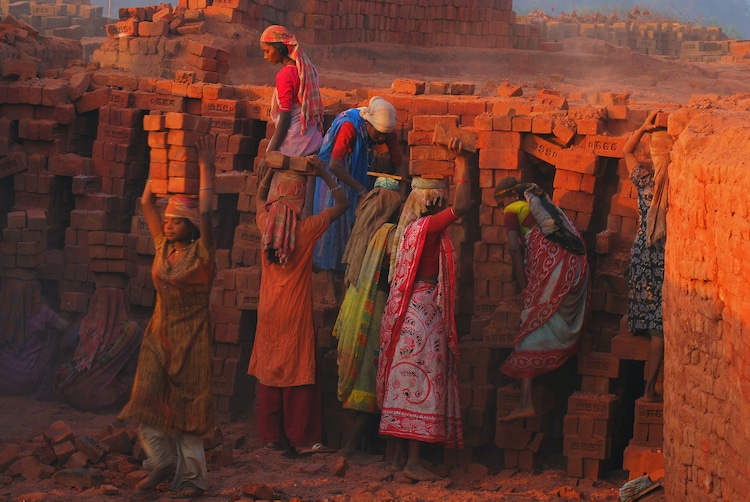
Female labour participation declining in India: Why are women not working?
Less than 20% of India's women work at paid jobs and female workforce participation has been declining in the country. Here are the factors holding women back from paid jobs in rural and urban settings.

It was in 1848 that India got its first school for girls, thanks to Savitribai Phule and her husband, Jyotirao Phule. Thirty-five years later, India and the British Empire got their first female graduates -- Chandramukhi Basu and Kadambini Ganguly.
You may think 140 years would be a good enough time for India to go from receiving its first female graduates to reaching gender parity in the labour force contributing to the country's economy. But in 2023, that is sadly still not true.
Data from the International Labour Organisation (ILO) states that the employability gender gap in India is 50.9%, with only 19.2% of women in the labour force compared to 70.1% of men.
As per World Economic Forum's Gender Gap Report 2022, India ranked 135 out of 146 countries and was behind smaller neighbours such as Sri Lanka, Bangladesh and Nepal. It is one of five nations, including China, Pakistan, Azerbaijan, and Qatar, with gender inequalities exceeding five percent.
The World Economic Forum (WEF) has highlighted that progress towards gender parity has been halted and even reversed due to the Covid-19 pandemic. The pandemic disproportionately affected women, leading to what is widely known as the "shecession," as sectors like retail and hospitality, where women are more prevalent, were significantly impacted.
The WEF says that at the current rate of progress, it will take 132 years for the world’s labour force to reach full gender parity.
The increased involvement of women in entrepreneurship has the potential to boost India's GDP by $0.7 trillion by 2025, says an Indian Express report.
By establishing and running their own businesses, women entrepreneurs can not only generate employment opportunities for other women but also inspire them to enter the workforce. This, in turn, can lead to significant economic growth.
India however has a number of factors that hold women back from paid work – in both rural and urban settings.
FEMALE WORKFORCE PARTICIPATION DECLINING IN INDIA
As per ILO, 52% of women in India express a desire to work either in paid jobs or in both paid jobs and care for families and homes.
But surprisingly, India's female labour participation rate has been surprisingly declining over the past two decades, dropping from 32% in 2005 to 19% in 2021.
This downward trend applies to women across different social classes, religions, and age groups, including rural women who may rely on income the most.
According to data from the Centre for Monitoring Indian Economy (CMIE), unemployment rates in rural areas experienced a sharp increase to 9.2 percent in February 2022, whereas urban areas witnessed a reversal in the previous trend, reaching 7.5 percent. Despite the stats, one in four urban women, aged 15-29, are unable to secure employment.
FACTORS HOLDING WOMEN BACK FROM PAID LABOUR
The factors holding women back from employment can be a little different in rural and urban areas. But in many cases, they overlap as well.
Here are the major factors behind the low rate of women employment in India:
1. Unpaid labour and vulnerable employment
Measuring female labour accurately is challenging as it often involves unpaid work that goes unrecognised. Women's contributions to household chores, caregiving, and other unpaid activities are not adequately accounted for, leading to an underestimation of their labour force participation.
Women are often engaged in low-paying and exploitative jobs in the private sector, while the contraction of public sector jobs further exacerbates gender disparities.
Women are also more likely to be a victim of vulnerable employment. Here are a few types of vulnerable employment as per ILO data:
- Women often work fewer hours than men involuntarily, experiencing ‘time-related underemployment’ rates of up to 46% in developing countries.
- Women perform over three times more unpaid household and care work than men, impacting their ability to engage in paid work.
- Many employed women are contributing family workers, often poorly paid and lacking social protection.
- Lack of statutory rights to maternity leave and limited access to social protection further hinder women's employment opportunities.
- Women face lower entitlements to social protection, particularly in pension schemes.
Moreover, unemployment rates alone do not provide a complete picture of the crisis, as they fail to account for individuals who have stopped searching for jobs after repeated unsuccessful attempts. Women constitute a considerable portion of this group, intensifying the severity of the situation.
2. Societal norms and gender roles
Conservative societal norms in India prioritise women's roles within the family, often leading them to leave their jobs, especially after marriage or after having children.
The expectation of fulfilling domestic responsibilities and caregiving roles can hinder women's participation in the workforce.
3. Gender pay gap
The Oxfam India Discrimination Report 2022 highlighted the gender pay gap in India, with women facing bias in recruitment and pay across the country.
Disparities in earnings were observed across casual work, regular jobs, and urban self-employment, further reinforcing the gender wage gap.
The gender pay gap is also evident in technology roles, with women earning less than men, even more so in senior management positions.
4. Need for better government measures, laws and economic policies
Despite existing legislation such as the Equal Remuneration Act and the Minimum Wages Act, women's labour is undervalued in rural areas, the unorganised sector, and the private sector.
India's gender parity ranking has declined, highlighting the need for the Women's Reservation Bill to ensure equal political representation.
Weak job creation, faulty economic policies, and insufficient investment in unorganised sectors, micro, small, and medium enterprises, and rural development contribute to the scarcity of gainful employment for both genders.
Pro-corporate policies and changes in labour laws have made livelihoods more vulnerable, and the recent budget fails to address food security, employment generation, and social services.
Inadequate budgetary allocations for women and children hinder the progress of welfare schemes, while weakened programmes and limited spending on women's safety perpetuate challenges in the workforce.
5. Gender inequality and lack of suitable job opportunities for women
Data reveals a significant disparity in labour force participation rates between men and women in India.
Some sectors, particularly male-dominated ones like manufacturing, present barriers to entry for women entrepreneurs and employees.
Additionally, women's representation in high court judgeships remains below 10 percent.
A lack of decent and accessible job options hinders women from entering or remaining in the workforce.
6. Reliance on agriculture
The significant reliance on agriculture for employment in rural areas, despite its declining share in the economy, contributes to the overall employment constraints.
The stagnant growth in the secondary sector, particularly in manufacturing, poses a challenge in transitioning employment opportunities from agriculture to industries that provide better prospects.
7. Increased prosperity
As household incomes rise, women – particularly in urban areas -- are leaving the workforce because they no longer need to engage in physically demanding labour.
Improved financial stability enables some women to prioritise their family responsibilities over pursuing employment.
8. Choosing education over work
Many women prioritise education, which temporarily takes them out of the workforce, but they face challenges in finding suitable jobs upon completion of their studies.
However, dropping out of work is a privilege largely restricted to urban women.
9. Safety concerns
Migration and safety concerns further limit women's access to employment. Inadequate urban infrastructure, along with safety issues in public spaces, can discourage women from seeking and retaining jobs, particularly in urban areas.
HOW TO TACKLE PROBLEMS PREVENTING WOMEN’S EMPLOYMENT
If India wants its women to work, we need to see an array of changes at an individual, societal and governmental level that can create a supportive environment
To sustain progress and economic growth, it is crucial for India to address these challenges and recognise the importance of women's contribution, both economically and socially.
"Empowering women in the workforce requires more than just motivation; it calls for thoughtful policy, quality childcare, and mentorship backed by inclusive rules,” explains Naghma Mulla, CEO of EdelGive Foundation, the philanthropic initiative of Edelweiss Group.
“Women face a myriad of issues at workplaces and it is the responsibility of corporations, policymakers, and the government to foster a supportive environment with adequate facilities for childcare, and mentorship and counselling for women who are joining work after maternity break,” she adds.
“Furthermore, including men on this journey is the key to its success. Giving them an opportunity to participate in improving conditions for women instead of mandating rushed changes in rules to manage stakeholders will go a long way in the true journey of empowering women at work,” adds the CEO.
The International Labour Organisation suggests the following strategies to bridge the workforce gender gap:
- Ensuring equal pay for work of equal value through legal protection, wage transparency, and gender-neutral job evaluation.
- Addressing occupational segregation by challenging preconceived notions about the value of certain types of work.
- Eliminating gender discrimination and harassment through legislation, effective remedies, and awareness campaigns.
- Promoting work-family balance through adequate maternity protection, paid paternity and parental leave, and social protection measures.
- Creating quality care jobs and improving regulation and protection for care professionals.
- Implementing gender-responsive policies to safeguard women's employment during economic downturns.
To foster women's entrepreneurship and employment in India, we need initiatives such as financial support for women entrepreneurs, improved education and training access, gender equality promotion, safety and security measures, increased job opportunities, better work policies, and affordable child care.
Creating an inclusive environment that empowers women is crucial for India's growth trajectory, necessitating continuous evaluation of efforts to challenge stereotypes and encourage female labour force entry.
Promoting gender equality and increasing women's participation in the workforce are critical steps toward leveraging India's demographic dividend and achieving sustainable growth.




